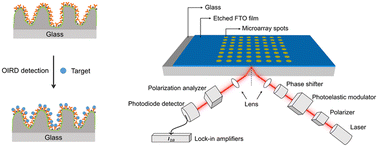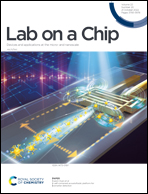Label-free OIRD microarray chips with a nanostructured sensing interface: enhanced sensitivity and mechanism†
Abstract
Oblique-incidence reflectivity difference (OIRD) is a novel optical technique for protein microarray detection with the characteristics of being real-time, label-free, high-throughput and compatible with arbitrary chip substrates. It is necessary yet challenging to improve the sensitivity of the OIRD microarray and gain a clear understanding of the enhancement mechanism for practical applications. In this study, we report a microarray chip specifically designed for OIRD to improve its sensitivity by using an electrochemically etched nanostructured fluorine-doped tin oxide (FTO) slide as the substrate. Compared with chips printed on a conventional glass slide and pristine FTO, the OIRD sensitivity and signal-to-noise ratio of this microarray are significantly improved, reaching a limit of detection (LOD) as low as 50 ng mL−1 for the streptavidin target in 10% human serum, which is one order of magnitude lower than that of the glass-based chip. On-chip ELISA and theoretical calculation reveal that the enhanced sensitivity is not only because of its higher capture efficiency towards the target, but also benefits from the optical enhancement enabled by its unique nanostructured sensing interface. This work provides a new universal strategy for designing high performance OIRD-based chips via rational interfacial engineering, thus paving the way to a label-free OIRD immunoassay and real-time analysis of biomolecular interactions.



 Please wait while we load your content...
Please wait while we load your content...